
The best 1st year math activities to print with exercises of sum with little fingers, containing organized questions that are easy for students to understand, as it has illustrative images that can be colored at the teacher's discretion.
In this post we selected a sequence of math activities, Hope you like it.
Index
Answering requests, check out an update in the post with new ones educational activities recommended for students of 1 (first) year of elementary school, Look:
For this activity we will need:
The activity (operations data) has as its main objective:

This math activity has the following objectives:
Check the form with the step-by-step activity:

handout of Math Activities, recommended for students in the first year of elementary school, for free PDF download.
Let's go to train addition in classroom or homework? Check out these 3 ready-to-print activities.
Subtraction:
Let's go train subtraction in classroom or homework? Check out these ready-to-print activities.
Several suggestions for math activities for 1st year elementary school students, are simple exercises, ready to save and print only.
All math activities are in an excellent format, ready to apply in the classroom:
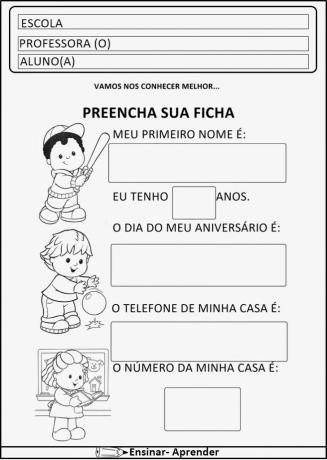

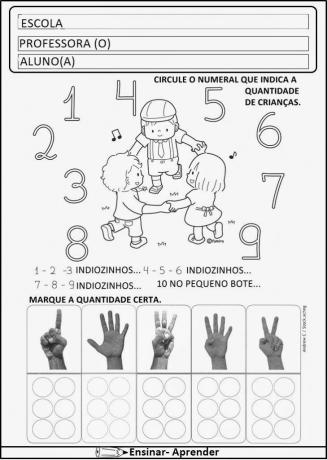


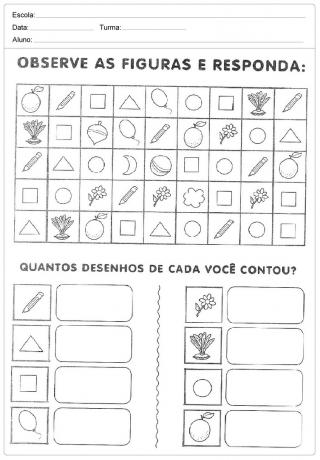
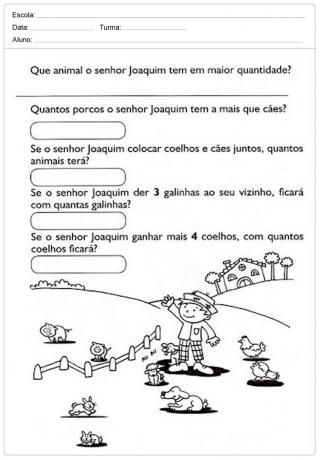
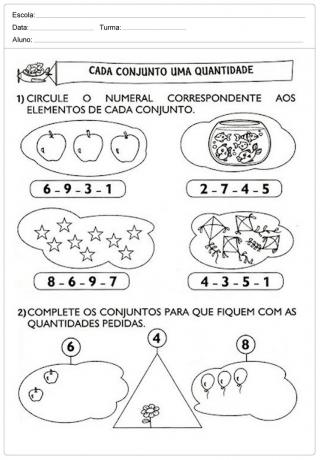

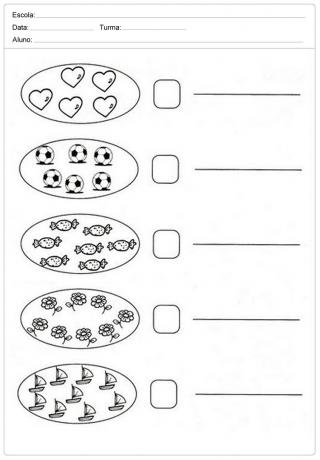

We selected some Math activities for the 1st year of elementary school, are activities of Addition and Subtraction for initial series.
First let's go with the shrinking exercises. check out:

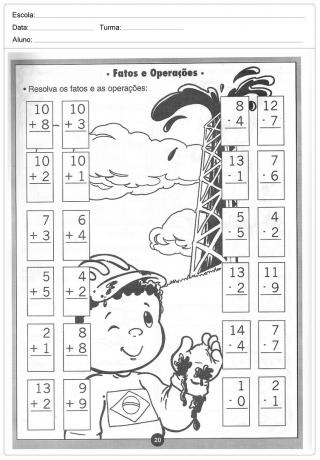
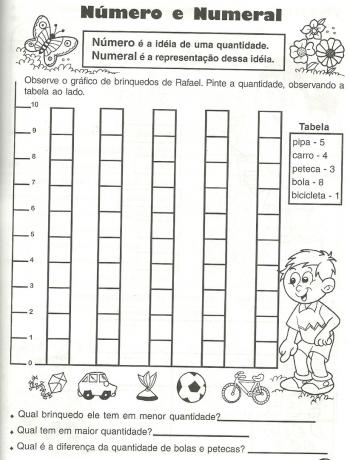
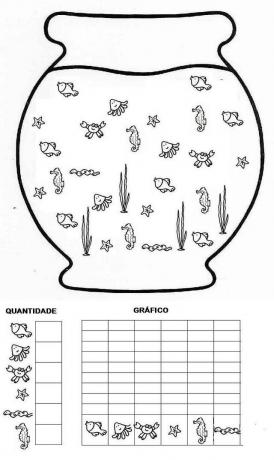
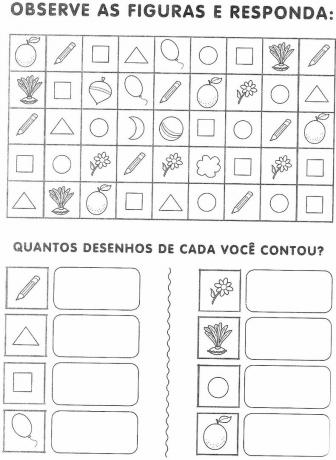
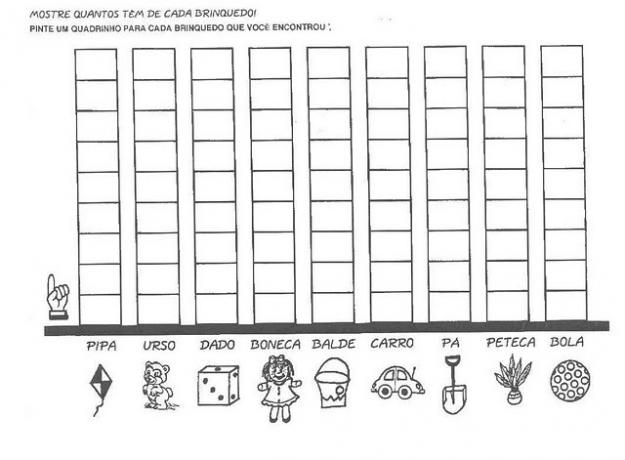
Sequence is every set or group in which its elements are written in a certain order. In the study of mathematics we study a type of sequence: a numerical sequence. That sequence that we study in mathematics is made up of numbers that are arranged in a certain pre-established order.
The teacher explores the table below, which is composed of a board with the 50 numerals. Below is a model:

Orally explore the board with the children asking questions such as:
At this point, the students make comparisons and the teacher follows the hypotheses presented, both in numerical sequence from one to one, as well as, in the understanding of counting from 10 to 10, as provided for in the questions prepared by the teacher.
There are numerous explorations that the teacher can carry out with this board, even making the assembly with them, as in the previous suggestion, each child receives a number of tokens and builds up to complete the sequence until the number 50.
___
A very fun activity to work colors, numbers, groups and numerical sequence
print 20 Educational Activities by calling Numbers 1 to 20 to work with your students or children on motor coordination and math ordering.
In these educational activities, numbers form animals. Check out:
This material that reaches your hands was produced with the intention of helping you to build good activities for teaching and
learning mathematics in the 1st year of schooling. It should not be used as a didactic sequence, as although they are
according to the Curriculum Proposal of the Municipal Department of Education of Duque de Caxias, these forms do not cover all
learning situations that your students will need to experience in order to appropriate the knowledge listed for this
time course.
When we build the sheets, we think about an age-appropriate formatting and activities that our students would feel
encouraged to perform. Some may, at first glance, seem very common. However, we were careful to register some
guidelines that will help in the application of the forms and justify the teaching conception in which we believe.
These 1st year math activities composed of dozens and units containing problem-situations and challenges that are great allies in the teaching-learning process of Mathematics. Our challenge has an adequate space for solving activities, with new images and easy-to-read typology for students in the literacy process.
The content brings activities that are part of the child's universe that create contexts for approaching Mathematics. The activities are intended to help the child's development so that he can learn more easily what was taught by the teacher.

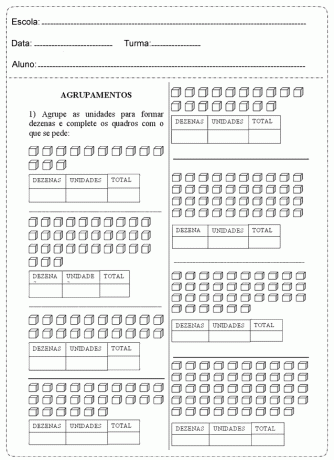
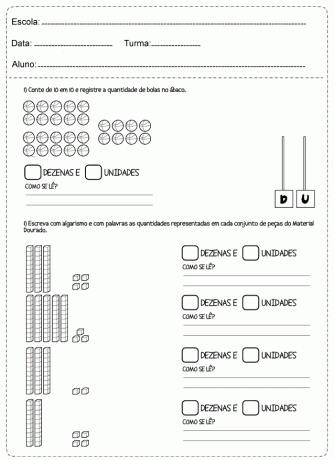
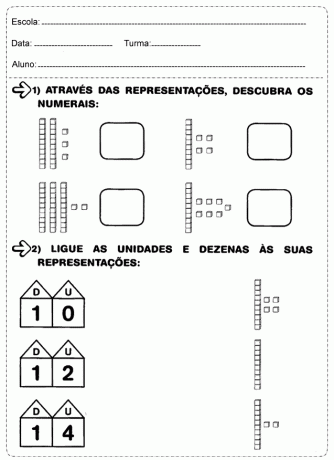

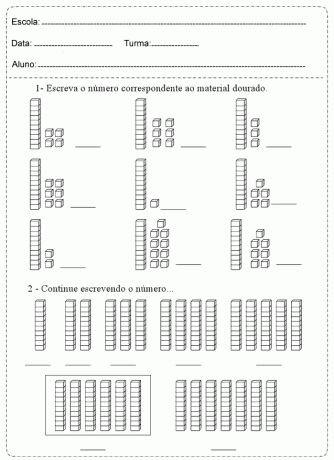
This is the way to organize the numbers according to their position. The last digit on the right corresponds to the unit.
The previous one is ten and the first one from the left is one hundred. So, you have 5 units, 4 tens and 2 hundreds, remembering that a dozen has 10 units and a hundred has 100 units.
____________________
Update 2020 !!
Below are some suggestions for situations math problems for students of first year of school.
In total there are 12 problem situations (Math activities) to work in the classroom or as a homework assignment.
Fill in: Write the numbers corresponding to the figures in the squares below:
Help the little calf find its mother by walking along the path with the 10 out of 10 crescent sequence.
Count the elements of each set and write the corresponding numeral. Then use the sign.
Then compare the numerals.
Connect sets that have the same number of elements and mark the number of elements.
Count how many pictures are in each set and paint the square with the corresponding number.
Look at the animal chart.
Count the animals of each species and record the amount below by painting a square for each animal. Then write the corresponding numeral.
Color the bunch that has many grapes.
A wonderful strategy for working math in the first year of elementary school is the use of playful resources.
Some objects and tips that you can use:
I - Count:
A) Songs:
Elephant
An elephant bothers a lot of people.
Two elephants annoy, annoy much more.
Three elephants bother a lot of people.
Four elephants annoy, annoy, annoy, annoy much more.
Five elephants annoy a lot of people.
Six elephants annoy… Much more.
Seven eight nine ten.
indians
One two Three Little Indian.
Four, five, six little indians.
Seven, eight, nine little indians.
Ten in a small boat.
They were sailing down the river
when the alligator approached
And the little indians boat
Almost, almost turned!
(but not turned)
Mariana
Mariana counted one, told Mariana one.
It's one, it's one, it's one, it's Ana.
Long live Mariana, long live Mariana.
2, 3, 4, 5, 6,…
Popcorn
A popcorn in the pan,
Another one came to talk.
It was tremendous talk
that no one could stand
And it was such a:
Poqui poqui poqui poqui
poqui poqui poqui
poqui poqui poqui
two popcorn in the pan
Another two came to talk
It was tremendous talk
That no one could stand...
(count to five – children at the time of the chorus should clap their fingers as if they were clapping, first just one finger on the other, then two, three… until they clap, that is, five fingers).
little worms
A little worm doing gymnastics
Two little worms doing gymnastics
Three little worms doing gymnastics
Four little worms doing gymnastics
Five little worms doing gymnastics
A worm doing gymnastics
A worm doing gymnastics
B) Jokes – hopscotch, snail, hide and seek, games to choose from.
• Mom, can I go?
Choosing a child to be the mother, placing him at a distance from the other children.
Children ask "Mama can I go?" The child who is in the role of the mother answers yes and the others ask: "How many steps?" The mother decides the number of steps each child will take. The one who reaches the mother first wins.
• Forming sequence:
Spreading numbered cards on the patio floor, children should walk around the patio freely, at the teacher's signal. each student has to pick a card randomly and must form a group where there is a complete sequence (1 to 9, per example).
II - Quantification
A) Songs
One
one is one
one is one
A nose, a mouth,
A neck, a belly,
Navel just one...
I clap a hand,
I jump,
I hide a hand
And with the other a big kiss.
(Thelma Chan – CD Rattled)
Two
You and I
We are two.
you sing before
I sing later.
You and I
we are two
you sing before
I sing later
have two eyes in your face
have two eyes in your face
Two ears you have.
Two ears you have.
the eyes are for seeing
the eyes are for seeing
the ears to hear well
the ears to hear well
one plus one two
(Thelma Chan – CD Rattled)
Three
Three little jumps one, two, three.
One plus one plus one is three
There are three of us, me and you.
Put three fingers one, two, three.
tell now in chinese
Whoa, u, sam
and in japanese
It, ni sam.
(Thelma Chan – CD Rattled)
B) Jokes
• Quantity memory: it is played as in the traditional way, however, the cards are prepared with pairs of numbers and their respective quantities.
• Numerical run: students must walk freely around the courtyard, at the teacher's signal, to form groups according to the amount requested.
• Numeral and Quantity (EVE):
The educator will initially use only the parts with shapes representing quantity. The association will be carried out without numerical symbology, only by counting shapes and fitting these parts;
The same activity as before, associating symbol and quantity (shapes). After completing the association, the child will be able to copy the figure graphically and present the respective amount;
The educator will ask the group to remain seated in a circle and place the pieces with the numbers facing down and shuffled in the center. When he calls a child, he will give him a piece with a number, for example 5, and ask him to gather the necessary number of colleagues to form a set with the number represented.
After distributing the pieces among the children, the educator will ask one of them to show their piece and that the others who have the complementary pieces in their hands should join it. So it will be repeated with all digits.
• Run and catch: the teacher prepares several cards with amounts of different objects. Students must walk freely around the courtyard, at a given time the teacher speaks a number and students must find which cards have the requested amount.
• Four corners: (with music playing) Four children, or four groups of three or more children (for everyone to participate) stand at each corner of a square and only one child is in the center. When the music starts, they switch places and, meanwhile, the child at the center tries to take one of the places, which can only have the number of children already stipulated. The one that finds itself out of place is in the center and the game starts again.
• Number groups: the teacher leaves cards with numerals scattered around, at a signal the students run, pick up a card and then group together with all those with the same number.
III - Forms
• Changing the picture: the teacher draws several circles, squares and triangles on the floor and the children must walk over them following the order of the teacher, when he says "circle" they can only step on the circle, but when he says "square" they must immediately change and just step in this figure. This game has no winner, it is only for checking and fixing the geometric shapes
• Find out what's missing (Logic Blocks): place 4-5 pieces on the table, look for a moment and close your eyes; another person removes one of the pieces, when opening the eyes the child will have to say the characteristics of the piece that is missing.
• Sequence of Shapes: the child takes a card and with the pieces of the logical blocks he must assemble the presented sequence.
• Heads up! The picture is… : the teacher spreads various geometric figures across the courtyard. Students walk freely around the courtyard observing the figures, when the teacher speaks a figure everyone must run and pick up the requested figure.
IV - Quantities
separate objects by size
What is the biggest ball? In a circle, show balls of different sizes, letting the children hold them, observing and telling about their differences. The teacher will need to make interventions so that children can think about the possibilities of using such materials.
V - Space
A) Songs
Mazu
in and out
Mazu, Mazu.
in and out
Mazu, Mazu, Mazu.
I wash this window
Mazu, Mazu.
I wash this window
Mazu, Mazu, Mazu
I choose a partner
Mazu, Mazu.
I choose a partner
Mazu, Mazu, Mazu.
he dances cute
Mazu, Mazu
he dances cute
Mazu, Mazu, Mazu.
(*Public domain)
Green Stone Ring
i lost my ring
in the hole in the wall
Whoever finds gives me back
My green stone ring.
Time forward, forward
Time back. back
Time forward, forward
time back, back
(*Public domain)
Far close
if it's far
Can not reach
if it's close
I'll get.
Far close
near far
how delicious
I'm going to play.
Far close
near far
how delicious
I'm going to play.
(Thelma Chan – CD Rattled)
B) Jokes
the mysterious person
With students arranged in rows, the teacher selects one of them without the others knowing who it is. It then presents some clues about the chosen child so they can find out:
– The person I chose wears (or doesn't wear) glasses.
– The person I chose is sitting between a boy and a girl.
– The person I chose is in front of João and behind Laura.
__________
Subscribe to our email list and receive interesting information and updates in your email inbox
Thanks for signing up.


